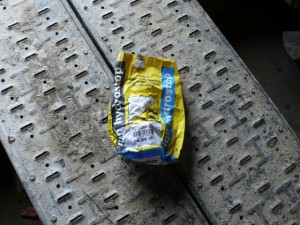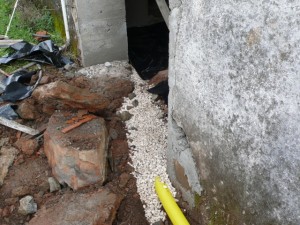Rising Damp
“Rising damp” may have a place in people hearts as a fantastic comedy of bygone years. The other form of rising damp is regarded quite differently.
Take an attractive stone Portuguese house built around a hundred years ago. As usual one of the “Adega or Loja” walls will be built against the earth. This is great from a cooling point of view. It will keep your wine nice and cold in the summer but from a damp and rot point of view its a nightmare.
When you turn the space into accommodation the work must be carefully considered and carried out to the highest quality. The risk of rising damp forcing its way into your living space will cause problems that are hard and expensive to fix.  Shows water pressure climbing up the wall and pushing off the paint on this external wall. You can use a better quality paint but over time it will bubble and fall off the wall just the same.
Shows water pressure climbing up the wall and pushing off the paint on this external wall. You can use a better quality paint but over time it will bubble and fall off the wall just the same.
The only answer to fix the damp.  You can use an additive to make the new render waterproof.
You can use an additive to make the new render waterproof.  You can fit a dpm under the new floor (damp proof membrane)
You can fit a dpm under the new floor (damp proof membrane)
These are only basic operations to help stop damp they are not a solution on their own.
Rising damp: an in depth look at the problem and how to eradicate it from your home in Portugal
Take an attractive stone Portuguese house built around a hundred years ago. As usual one of the “Adega or Loja” walls will be built against the earth. This is great from a cooling point of view. It will keep your wine nice and cold in the summer but from a damp and rot point of view its a nightmare. When adding a damp proof membrane to the ground floor of the property it is a good idea to provide an exit for any humidity that may arise under the floor. This yellow perforated pipe does just that. Remember water runs downhill so make sure the vent tube also runs downhill.  Then lay the damp roof membrane. With no holes or rips in it.
Then lay the damp roof membrane. With no holes or rips in it.  This will provide a dry floor from which to develop your ground floor space. If you have a more than a little damp – a spring like this for instance.
This will provide a dry floor from which to develop your ground floor space. If you have a more than a little damp – a spring like this for instance.  You must follow a simple but thorough course of action. Drain and seal the floor,
You must follow a simple but thorough course of action. Drain and seal the floor,  Tank the walls
Tank the walls 
 Insulate the cavity and build a brick wall and plaster. This will produce a dry warm home with no chance of recurring damp. If you would like help with any damp related question please contact Casteloconstruction info@casteloconstruction.com
Insulate the cavity and build a brick wall and plaster. This will produce a dry warm home with no chance of recurring damp. If you would like help with any damp related question please contact Casteloconstruction info@casteloconstruction.com


